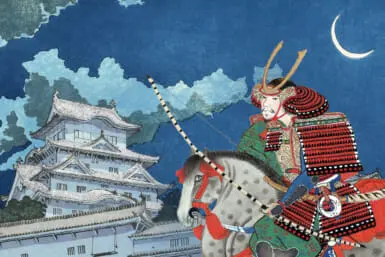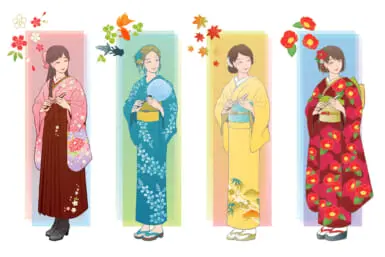Many years ago when I visited Japan for the first time, it was in mid-November. As my traveling companion and I toured Meiji Shrine on a crisp fall afternoon, we happened upon the annual Shichi-Go-San celebration. I’ll never forget the festive sight of hundreds of 7, 5 and 3-year-olds prancing about the grounds of the shrine. My photographs of families in gaily colored kimono and finest dress, posing against a backdrop of brilliant autumn leaves, remain some of my favorite memories of Japan.
Shichi-Go-San, literally seven, five and three, is celebrated each Nov. 15 as families throughout the country visit Shinto shrines to pray for the health of their children. Traditionally, boys and girls aged 3, boys aged 5, and girls aged 7 celebrate by dressing in kimono (for girls) or hakama and haori (for boys). In recent years an increasing number of children are seen wearing fancy Western-style dress.
The practice of honoring children with Shichi-Go-San originated with the aristocratic and samurai classes of Japan, but by the Edo period it had spread to the commoners. In medieval times, several rites of passage were observed on this day: 3-year-old boys and girls were allowed to stop shaving their heads and begin to grow their hair; 5-year-old boys wore their first hakama in public, and 7-year-old girls began to use the obi rather than cords to tie their kimono. Today’s children delight in dressing up in their best clothes and paying a visit to the priest at the local shrine where they receive special candy after the blessing.
The year that my oldest son turned 5 and his younger brother was 3, I was excited about celebrating Shichi-Go-San in Tokyo. I was looking forward to purchasing beautiful hakama for my little boys to wear, until I visited the department stores and saw the outrageous price tags. Upon hearing of my frustration, my Japanese neighbor offered her husband’s Shichi-Go-San hakama which had been in the family for three generations.
I politely declined, but the next day Kuroda-san appeared on my doorstep with a large bundle. As she unwrapped the layers of carefully folded silk, I realized that there were two sets of exquisitely embroidered hakama (trousers) with matching haori (jackets), just the right size for a 5-year-old and a 3-year-old. What a wonderful surprise for our family! Kuroda-san, the mother of grown daughters, was so sincere in her desire to loan us the clothes that I didn’t know how to refuse.
That weekend we set out for the blessing ceremony at the quaint Hikawa Shrine in Shirogane, not too far from our home. The boys were resplendent in their finery; Kuroda-san had come over that morning to help get them into the outfits, a real challenge with two squirming little guys. No appointment was necessary at Hikawa-jinja where the Shinto priest warmly welcomed our family and ushered us into the shrine. For a fee of ¥5,000 the priest performed a simple ceremony as my husband and I quietly prayed for the health and success of our sons. Fortunately, the boys were so fascinated by the ornate gold decorations and the dramatic presentation that they were able to sit still for this brief period, a great relief!
After the ceremony the children were each presented with onamori (a brocade talisman) and a bag of chitoseame candy. The word “chi-tose“‘ means one thousand years and is used to denote longevity. The bag was brightly decorated with illustrations of cranes and turtles, also symbols of a long life. The thought of opening the candy bag was a tantalizing bribe that encouraged the children to stand still long enough for a few photographs. After eating the candy, both boys were in high spirits, but somehow we managed to get home safely before the beautiful hakama were soiled or torn. Thanks again, Kuroda-san!
As Nov. 15 is not a national holiday in Japan, families often visit a shrine on the weekend before or after that date. You still have time to experience this very special Japanese tradition with your children. Check out local Shinto shrines in the neighborhood, or you may want to visit Hie Shrine in Akasaka, a popular destination for families celebrating Shichi-Go-San. May your little ones live long and prosperous lives!









